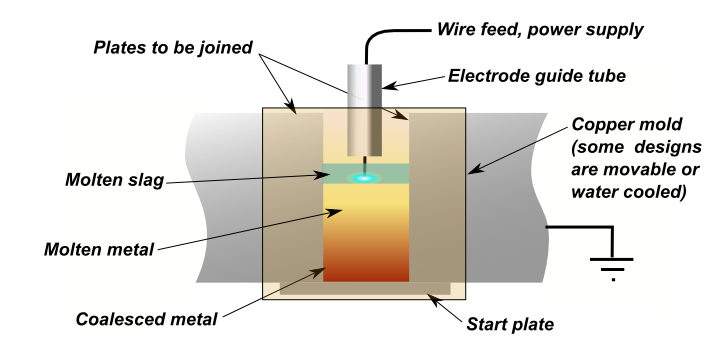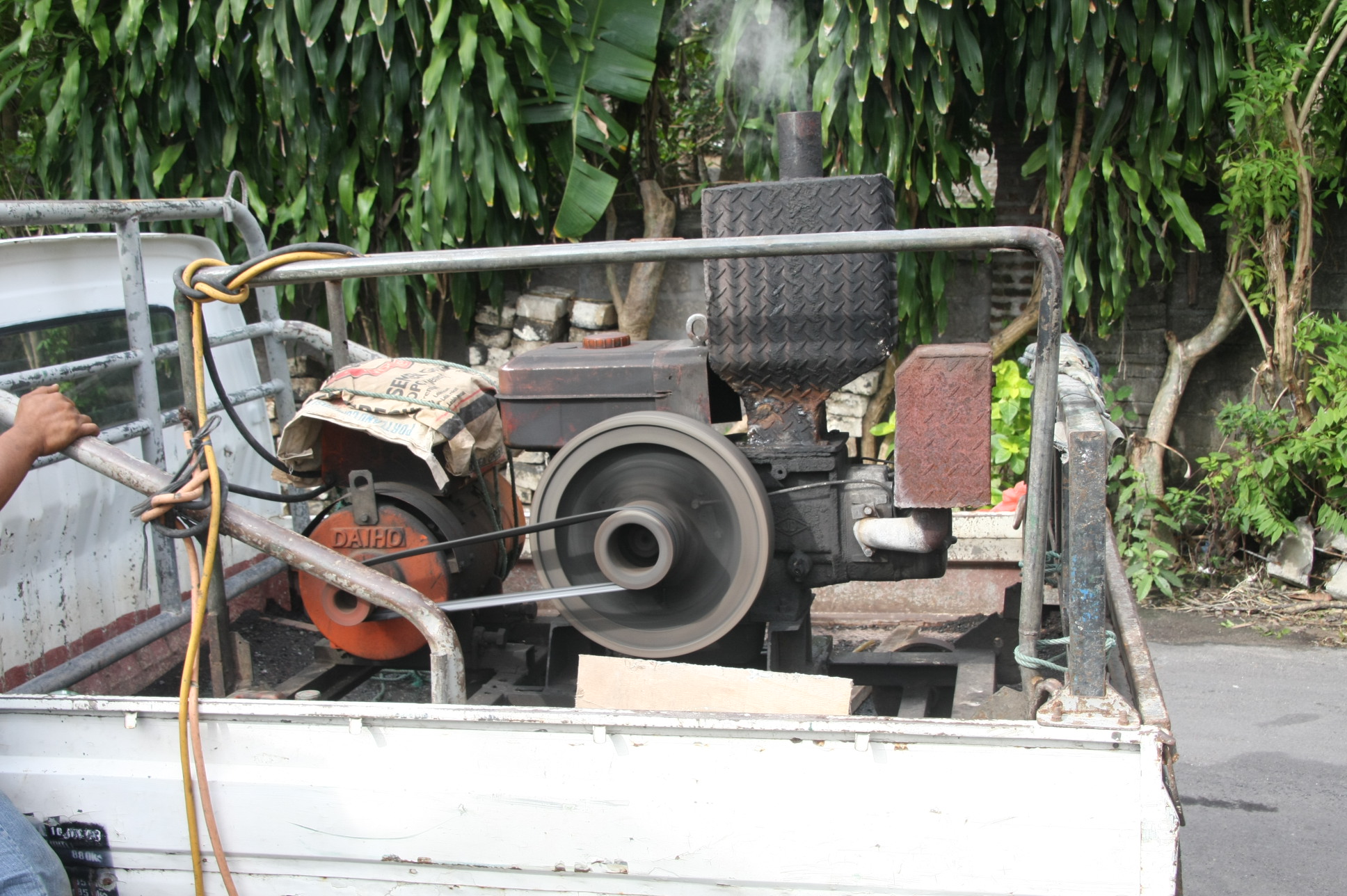|
Hardfacing
Hardfacing is a metalworking process where harder or tougher material is applied to a base metal. It is welded to the base material, and generally takes the form of specialized electrodes for arc welding or filler rod for oxyacetylene and gas tungsten arc welding welding. Powder metal alloys are used in (PTA) also called powder plasma welding and thermal spray processes like high-velocity oxygen fuel coating, plasma spray, spray and fuse, etc. Submerged arc welding, FCAW (Flux Core Arc Welding) and MIG (Metal Inert Gas) / MAG (Metal Active Gas) uses continuously fed wire varying in diameter depending on process and current. Strip cladding process uses strips from 50 mm wide to 125 mm with a thickness of 0.5mm. Open arc welding uses continuously fed tubular electrode which may or may not contain flux. Hardfacing may be applied to a new part during production to increase its wear resistance, or it may be used to restore a worn-down surface. Hardfacing by arc welding is a surfacing oper ... [...More Info...] [...Related Items...] OR: [Wikipedia] [Google] [Baidu] |
NOREM
NOREM is a hardfacing material developed by the Electric Power Research Institute to deal with radiation safety issues associated with the use of cobalt alloys in nuclear power station coolant systems (see stellite for a discussion of the problem). It is a solid-solution strengthened austenitic matrix with a continuous network of eutectic and non-eutectic carbides at the grain boundaries. It is intended to be deposited by various welding processes. Characteristics There are eight variants of NOREM currently available, depending on application and designated 02, 02A, 03A, 03B, 04A, 04B, 05A, 05B. A typical elemental composition is 60% iron, 25% chromium, 4.5% manganese, 4.0% nickel, 3.3% silicon, 2.0% molybdenum, 1.2% carbon. Earlier compositions included either significantly more manganese (12% in alloy 04) or significantly more nickel (8% in alloy M2). These are extremely hard alloys. NOREM 02 is ten times as resistant as 308 stainless steel to cavitation erosion. They are ... [...More Info...] [...Related Items...] OR: [Wikipedia] [Google] [Baidu] |
Thermal Spraying
Thermal spraying techniques are coating processes in which melted (or heated) materials are sprayed onto a surface. The "feedstock" (coating precursor) is heated by electrical (plasma or arc) or chemical means (combustion flame). Thermal spraying can provide thick coatings (approx. thickness range is 20 microns to several mm, depending on the process and feedstock), over a large area at high deposition rate as compared to other coating processes such as electroplating, physical and chemical vapor deposition. Coating materials available for thermal spraying include metals, alloys, ceramics, plastics and composites. They are fed in powder or wire form, heated to a molten or semimolten state and accelerated towards substrates in the form of micrometer-size particles. Combustion or electrical arc discharge is usually used as the source of energy for thermal spraying. Resulting coatings are made by the accumulation of numerous sprayed particles. The surface may not heat up significant ... [...More Info...] [...Related Items...] OR: [Wikipedia] [Google] [Baidu] |
Welding
Welding is a fabrication (metal), fabrication process that joins materials, usually metals or thermoplastics, by using high heat to melt the parts together and allowing them to cool, causing Fusion welding, fusion. Welding is distinct from lower temperature techniques such as brazing and soldering, which do not melting, melt the base metal (parent metal). In addition to melting the base metal, a filler material is typically added to the joint to form a pool of molten material (the weld pool) that cools to form a joint that, based on weld configuration (butt, full penetration, fillet, etc.), can be stronger than the base material. Pressure may also be used in conjunction with heat or by itself to produce a weld. Welding also requires a form of shield to protect the filler metals or melted metals from being contaminated or Oxidation, oxidized. Many different energy sources can be used for welding, including a gas flame (chemical), an electric arc (electrical), a laser, an electron ... [...More Info...] [...Related Items...] OR: [Wikipedia] [Google] [Baidu] |
Submerged Arc Welding
Submerged arc welding (SAW) is a common arc welding process. The first SAW patent was taken out in 1935. The process requires a continuously fed consumable solid or tubular (metal cored) electrode. The molten weld and the arc zone are protected from atmospheric contamination by being "submerged" under a blanket of granular fusible flux consisting of lime, silica, manganese oxide, calcium fluoride, and other compounds. When molten, the flux becomes conductive, and provides a current path between the electrode and the work. This thick layer of flux completely covers the molten metal thus preventing spatter and sparks as well as suppressing the intense ultraviolet radiation and fumes that are a part of the shielded metal arc welding (SMAW) process. SAW is normally operated in the automatic or mechanized mode, however, semi-automatic (hand-held) SAW guns with pressurized or gravity flux feed delivery are available. The process is normally limited to the flat or horizontal-fillet w ... [...More Info...] [...Related Items...] OR: [Wikipedia] [Google] [Baidu] |
Chromium Carbide
Chromium(II) carbide is a ceramic compound that exists in several chemical compositions: Cr3C2, Cr7C3, and Cr23C6. At standard conditions it exists as a gray solid. It is extremely hard and corrosion resistant. It is also a refractory compound, which means that it retains its strength at high temperatures as well. These properties make it useful as an additive to metal alloys. When chromium carbide crystals are integrated into the surface of a metal it improves the wear resistance and corrosion resistance of the metal, and maintains these properties at elevated temperatures. The hardest and most commonly used composition for this purpose is Cr3C2. The mineral form of the Cr3C2 compound is tongbaite. Isovite, , is a related mineral. Both are extremely rare. Yet another chromium-rich carbide mineral is yarlongite, Cr4Fe4NiC4.Mindat, http://www.mindat.org/min-35899.html Properties There are three different crystal structures for chromium carbide corresponding to the three differ ... [...More Info...] [...Related Items...] OR: [Wikipedia] [Google] [Baidu] |
Stellite
Stellite is a range of cobalt-chromium alloys designed for wear resistance. The alloys may also contain tungsten or molybdenum and a small, but important, amount of carbon. History Stellite is a trademarked name of Kennametal Inc. Prior to that it was owned by Union Carbide, Stellite Division. Invented by Elwood Haynes in the early 1900s as a material for making cutlery that wouldn't stain or require constant cleaning. Composition Stellite alloys are a range of cobalt-based alloys, with significant proportions of chromium (up to 33%) and tungsten (up to 18%). Some of the alloys also contain nickel or molybdenum. Most of them are fairly high carbon content when compared to carbon steels, though they contain less than 3% iron, and in the stellite alloys the carbon is primarily associated with the chromium to form hard chromium carbide particles which are dispersed in the cobalt-based matrix. Properties Stellite is a family of completely non-magnetic and corrosion-resistant co ... [...More Info...] [...Related Items...] OR: [Wikipedia] [Google] [Baidu] |
Cladding (metalworking)
Cladding is the bonding together of dissimilar metals. It is different from fusion welding or gluing as a method to fasten the metals together. Cladding is often achieved by extruding two metals through a die as well as pressing or rolling sheets together under high pressure. The United States Mint uses cladding to manufacture coins from different metals. This allows a cheaper metal to be used as a filler. For example, dimes and quarters struck since 1965 have cores made from pure copper, with a clad layer consisting of 75% copper and 25% nickel added during production. Laser cladding is an additive manufacturing approach for metal coatings or precise piece restorations by using high power multi-mode optical fiber laser. Roll bonding In roll bonding, two or more layers of different metals are thoroughly cleaned and passed through a pair of rollers under sufficient pressure to bond the layers. The pressure is high enough to deform the metals and reduce the combined thickness ... [...More Info...] [...Related Items...] OR: [Wikipedia] [Google] [Baidu] |
Plasma Transferred Arc Welding
Plasma or plasm may refer to: Science * Plasma (physics), one of the four fundamental states of matter * Plasma (mineral), a green translucent silica mineral * Quark–gluon plasma, a state of matter in quantum chromodynamics Biology * Blood plasma, the yellow-colored liquid component of blood, in which blood cells are suspended * Cytoplasm, a jelly-like substance that fills cells, suspends and protects organelles * Germ plasm, a zone in the cytoplasm determining germ cells * Germplasm, describes a collection of genetic resources for an organism * Milk plasma or whey, the liquid remaining after milk has been curdled and strained * Nucleoplasm, a highly viscous liquid that surrounds the chromosomes and nucleoli * Plasma cell, white blood cells that secrete large volumes of antibodies * Protoplasm, the entire living substance inside the cell membrane or cell wall Technology * Plasma (engine), a real-time 3D game engine from Cyan Worlds * Plasma display, a flat-panel electronic visu ... [...More Info...] [...Related Items...] OR: [Wikipedia] [Google] [Baidu] |
Electroslag Welding
Electroslag welding (ESW) is a highly productive, single pass welding process for thick (greater than 25 mm up to about 300 mm) materials in a vertical or close to vertical position. (ESW) is similar to electrogas welding, but the main difference is the arc starts in a different location. An electric arc is initially struck by wire that is fed into the desired weld location and then flux is added. Additional flux is added until the molten slag, reaching the tip of the electrode, extinguishes the arc. The wire is then continuously fed through a consumable guide tube (can oscillate if desired) into the surfaces of the metal workpieces and the filler metal are then melted using the electrical resistance of the molten slag to cause coalescence. The wire and tube then move up along the workpiece while a copper retaining shoe that was put into place before starting (can be water-cooled if desired) is used to keep the weld between the plates that are being welded. Electroslag we ... [...More Info...] [...Related Items...] OR: [Wikipedia] [Google] [Baidu] |
Oxyfuel Welding
Principle of burn cutting Oxy-fuel welding (commonly called oxyacetylene welding, oxy welding, or gas welding in the United States) and oxy-fuel cutting are processes that use fuel gases (or liquid fuels such as gasoline or petrol, diesel, bio diesel, kerosene, etc) and oxygen to weld or cut metals. French engineers Edmond Fouché and Charles Picard became the first to develop oxygen-acetylene welding in 1903. Pure oxygen, instead of air, is used to increase the flame temperature to allow localized melting of the workpiece material (e.g. steel) in a room environment. A common propane/air flame burns at about , a propane/oxygen flame burns at about , an oxyhydrogen flame burns at and an acetylene/oxygen flame burns at about . During the early 20th century, before the development and availability of coated arc welding electrodes in the late 1920s that were capable of making sound welds in steel, oxy-acetylene welding was the only process capable of making welds of excepti ... [...More Info...] [...Related Items...] OR: [Wikipedia] [Google] [Baidu] |
Arc Welding
Arc welding is a welding process that is used to join metal to metal by using electricity to create enough heat to melt metal, and the melted metals, when cool, result in a binding of the metals. It is a type of welding that uses a welding power supply to create an electric arc between a metal stick ("electrode") and the base material to melt the metals at the point of contact. Arc welders can use either direct (DC) or alternating (AC) current, and consumable or non-consumable electrodes. The welding area is usually protected by some type of shielding gas (e.g. an inert gas), vapor, or slag. Arc welding processes may be manual, semi-automatic, or fully automated. First developed in the late part of the 19th century, arc welding became commercially important in shipbuilding during the Second World War. Today it remains an important process for the fabrication of steel structures and vehicles. Power supplies To supply the electrical energy necessary for arc welding processes ... [...More Info...] [...Related Items...] OR: [Wikipedia] [Google] [Baidu] |
Welding Procedure
Welding is a fabrication process that joins materials, usually metals or thermoplastics, by using high heat to melt the parts together and allowing them to cool, causing fusion. Welding is distinct from lower temperature techniques such as brazing and soldering, which do not melt the base metal (parent metal). In addition to melting the base metal, a filler material is typically added to the joint to form a pool of molten material (the weld pool) that cools to form a joint that, based on weld configuration (butt, full penetration, fillet, etc.), can be stronger than the base material. Pressure may also be used in conjunction with heat or by itself to produce a weld. Welding also requires a form of shield to protect the filler metals or melted metals from being contaminated or oxidized. Many different energy sources can be used for welding, including a gas flame (chemical), an electric arc (electrical), a laser, an electron beam, friction, and ultrasound. While often an industr ... [...More Info...] [...Related Items...] OR: [Wikipedia] [Google] [Baidu] |





